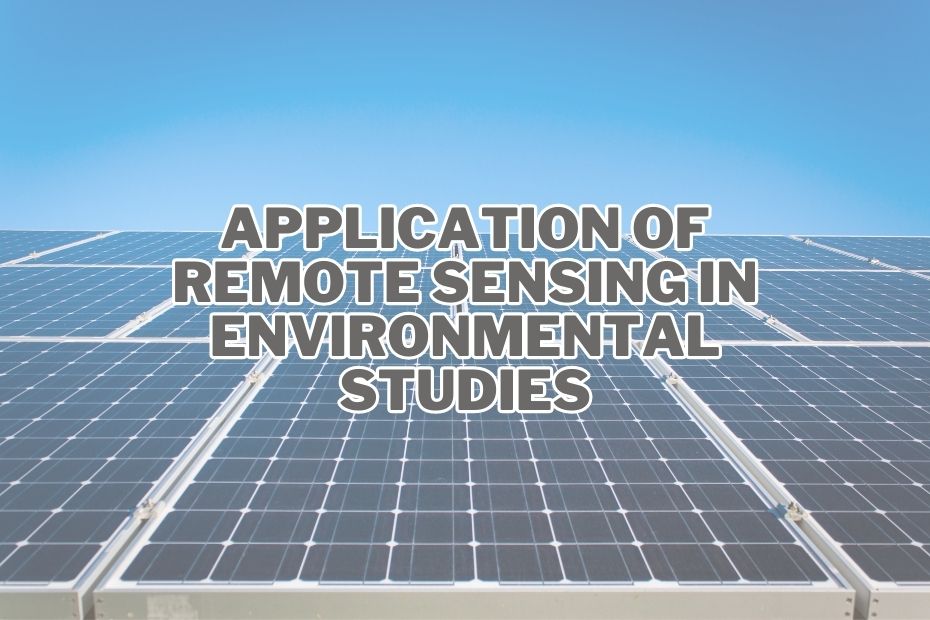Remote sensing, a technology that enables the acquisition of information about objects or areas from a distance, has proven to be an invaluable tool in environmental studies. By utilizing sensors mounted on aircraft or satellites, remote sensing provides researchers with the ability to gather data without direct physical contact. This article explores 11 key application of remote sensing in environmental studies, highlighting its significance in various domains.
Remote Sensing enables large-scale data collection on environmental parameters such as temperature, humidity, and vegetation cover, often in inaccessible areas. Its applications range from monitoring climate change impacts and tracking deforestation to assessing water quality and predicting natural disasters.
11 Application of Remote Sensing In Environmental Studies
Remote sensing is an incredibly powerful tool when it comes to environmental studies, providing unique insights that can drive our understanding of the Earth’s environment. Let’s dive into eleven remarkable application of remote sensing in environmental studies.
1. Land Cover Classification and Mapping
In environmental studies, accurate and up-to-date information about land cover is critical. Remote sensing provides a high-resolution view of the earth’s surface, facilitating the classification and mapping of different land cover types. From identifying forested areas, wetlands, to urban development, remote sensing technologies, such as multispectral and hyperspectral imaging, offer unparalleled data. These insights aid in urban planning, land use management, and habitat conservation initiatives.
2. Vegetation Monitoring
Remote sensing is a cornerstone in the modern approach to vegetation monitoring. Through techniques like Normalized Difference Vegetation Index (NDVI), remote sensors can analyze vegetation cover, growth patterns, and health from space. They can also detect changes in vegetation due to factors such as drought, disease, or deforestation. This invaluable data guides decisions on resource allocation, agricultural planning, and biodiversity conservation.
3. Climate Change Studies
Climate change is one of the most pressing issues of our time, and remote sensing plays a vital role in understanding its impacts. Satellites monitor sea level rise, ice cap melt, atmospheric CO2 levels, and temperature trends on a global scale. This irreplaceable data contributes to predictive models and guides international policy to mitigate climate change impacts.
4. Environmental Impact Assessment
Remote sensing aids in the critical task of Environmental Impact Assessment (EIA). By monitoring changes in land cover, water quality, and vegetation health before and after industrial projects, remote sensing provides objective, reliable data on the environmental impacts of human activities. This information can guide sustainable development practices and policies.
5. Water Resources Management
Remote sensing enables the monitoring and management of water resources, including lakes, rivers, reservoirs, and coastal areas. By analyzing satellite imagery, researchers can assess water quality, detect pollution sources, monitor changes in water levels, and support effective water resource planning and management.
6. Disaster Management
In disaster management, the speed and accuracy of information can save lives. Remote sensing provides real-time data on natural disasters such as floods, wildfires, earthquakes, and storms. It helps in predicting, monitoring, and mitigating the impacts of these events, and aids in efficient post-disaster recovery and planning.
7. Air Quality Monitoring
Air pollution is a grave environmental and public health issue. Remote sensing satellites, like NASA’s Aura, monitor air quality by measuring concentrations of pollutants like aerosols, carbon monoxide, and ozone. This data informs air quality forecasts, guides policy-making, and aids research on the health effects of air pollution.
8. Soil Mapping and Erosion Studies
Remote sensing plays a vital role in soil mapping and studying soil erosion. Using spectral signatures, sensors can identify different soil types, assess soil moisture levels, and detect changes due to erosion. This information is vital for agriculture, land management, and conservation planning.
9. Biodiversity Assessment and Conservation
Biodiversity conservation is another key area where remote sensing has immense utility. By providing detailed data on habitats, species distributions, and ecosystem health, remote sensing can help identify areas of high biodiversity, detect threats, and monitor the effectiveness of conservation strategies.
10. Coastal Zone Monitoring
Coastal zones are dynamic and vulnerable environments. Remote sensing allows for continuous monitoring of these areas, providing data on parameters like sea surface temperature, ocean color, and coastal landform changes. This information aids in managing fisheries, protecting marine habitats, and planning coastal defenses.
11. Archaeological Studies
Remote sensing techniques such as LiDAR (Light Detection and Ranging) have revolutionized archaeological studies. By using airborne or satellite-based sensors, researchers can identify buried archaeological features, map ancient landscapes, and uncover hidden archaeological sites that may be difficult to detect on the ground.
Conclusion:
In conclusion, remote sensing has a wide range of applications in environmental studies, revolutionizing the way researchers gather information about our planet. From land cover classification to climate change studies, from disaster management to archaeological investigations, remote sensing provides valuable insights that contribute to sustainable resource management and conservation efforts.
FAQs: Application of Remote Sensing In Environmental Studies
What are the advantages of remote sensing in environmental studies?
Remote sensing provides a cost-effective and efficient way to gather large-scale data, enables the monitoring of inaccessible or hazardous areas, allows for long-term data collection, and supports interdisciplinary research in environmental studies.
Can remote sensing be used for monitoring climate change?
Yes, remote sensing plays a crucial role in monitoring climate change. It provides data on key environmental parameters such as temperature, precipitation, and atmospheric composition, helping scientists understand and analyze long-term climate trends.
How does remote sensing contribute to disaster management?
Remote sensing helps in disaster management by providing real-time and near-real-time data on natural disasters such as floods, wildfires, and earthquakes. This information aids in assessing damage, planning rescue operations, and facilitating post-disaster recovery efforts.
